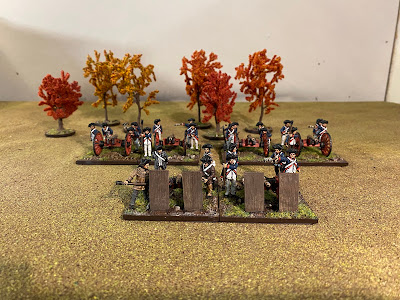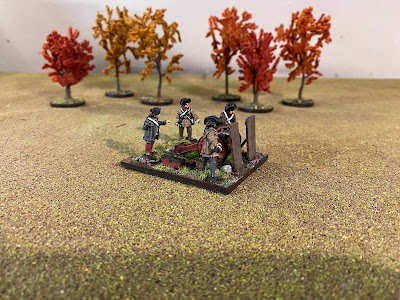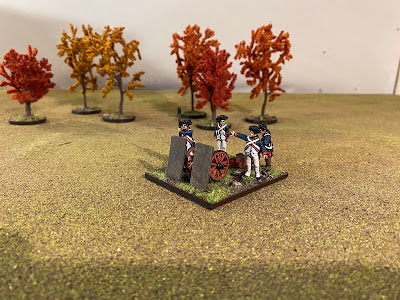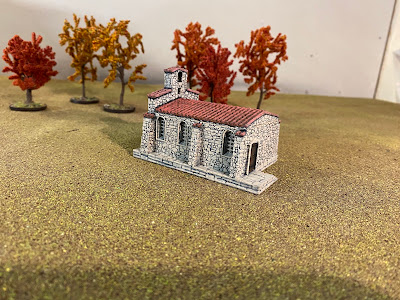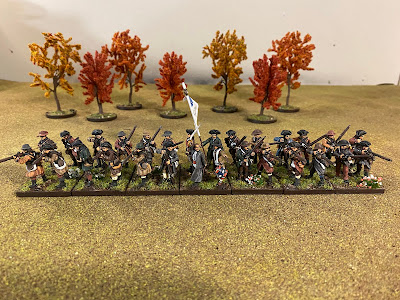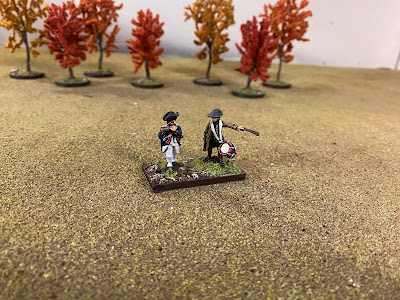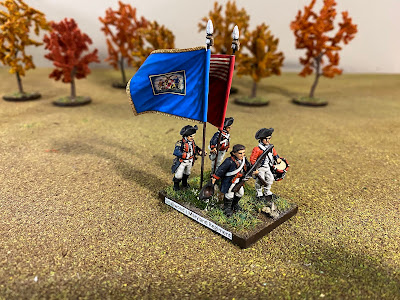I decided to do the three remaining Continental line regiments in the 'regulation' blue coats with red facings as I have enough variety in the eight already completed. They are all in the same firing line pose as well, so a few pictures should suffice to tell the whole story here:
The larger regiment of the three is Smallwood's 1st Maryland regiment which distinguished itself in several engagements including the Battle of Brooklyn, Guilford Courthouse and Cowpens:
I interspersed a number of figures in hunting shirts to fit in with contemporary descriptions of their appearance:
I also gave them both the GMB flags that came with the set, as befits a regiment of their stature:
Next up is the 2nd Maryland:
No hunting shirts here, but I did throw in a few different coloured coats:
The 2nd Maryland flag is quite eye-catching:
For the last of the line regiments I opted to do 1st Pennsylvania. These wore brown coats early in the war but were issued the red-faced blue coats under the General Order of October 1779, although there is no guarantee they actually received them:
They do however have a nice green flag, for something a little different:
I also managed to complete the last of the casualty/disorder markers:
That is eleven Continental Line regiments now completed:
I am now lining up five militia regiments.
With Easter imminent I was ready to launch into these, but in preparation for a DBMM game on Saturday this morning I started to put together the required troops.
My Samurai army is spread across three A3 sized storage boxes with flexible steel to ensure the figures remain in place, similar to the one below.
To my horror, when I opened the last of these the box nearly collapsed and all four hundred figures or so were waist deep in a fuzzy mould, looking like they were wading through mist. The PVA glue attaching them to their bases had also weakened, and three came off when I wobbled them slightly.
It looked like Brigadoon in there, and I wish now I had taken a photo but at the time I was too annoyed to want to record anything for posterity.
During the recent cyclone I had filled a bath and kept water in there for a couple of days before emptying it, just in case the water supply was cut off. It is one of those antique-style clawfoot baths with exposed pipes, but when I went downstairs to my painting room I noticed that water had dripped through. This had never happened before, probably because the dripping was only very slight and on the rare occasions when anyone has used the bath they are only in there for a relatively short time rather than days (although my water bill tells a different story).
The strange thing is that this particular box was stored in an enclosed book cabinet along with twenty or so others, but was the only one that suffered. I was immediately grateful for that.
Fearing that I would have to spend the whole of Easter rebasing four hundred Japanese peasants, I took the figures upstairs and drenched them twice in mould killer, with a four hour gap between applications, while leaving them in the sun all day.
Thankfully this seems to have done the trick. While my Japanese peasants now smell of mould killer the PVA has reset, and I hope all I am now looking is refreshing bleached static grass over which I will dab some PVA and sprinkle some fresh Army Painter static grass.
I'll also have to repaint the base edges as these now appear a little mottled. The thing I dislike the most about this hobby is having to go back over old projects to either rebase or repair damage, but hopefully I have found a way out of this one which should only cost me another three or four hours.
Stay tuned for more First-World problem resolutions, and hopefully some AWI Continental militia.
